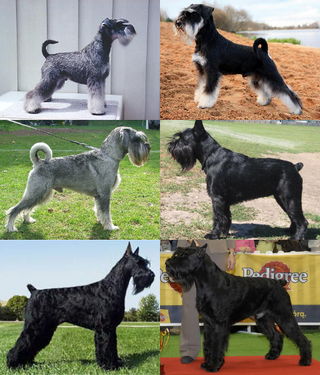Related Research Articles

Schutzhund, currently known competitively as IGP and previously as IPO, is a dog sport that tests a dog's tracking, obedience, and protection skills, and evaluates if a dog has the appropriate traits and characteristics of a good working dog. It was developed in Germany in the early 1900s as a suitability test for German Shepherds, but soon became the model for training and evaluating all five of the German protection breeds, which included Boxer, Dobermann, Giant Schnauzer, and Rottweiler. Though any breed of dog can participate, today the sport is dominated by German Shepherds and the Belgian Shepherd breed. Dog owners and handlers participate in Schutzhund clubs as a group activity for training the dogs, and clubs sponsor trials to test the dogs and award titles. The best dogs can qualify to participate in national and international level championships.

An assistance dog is a dog that receives specialized training to aid an individual with a disability in navigating everyday life. Assistance dogs can be trained by an organization, or by their handler.

The Miniature Schnauzer is a breed of small dog of the Schnauzer type that originated in Germany in the mid-to-late 19th century. Miniature Schnauzers may have been developed from the smallest specimens of the Standard Schnauzer, or crosses between the standard and one or more smaller breeds such as the Affenpinscher, Miniature Pinscher, and Poodles, as farmers bred a small dog that was an efficient ratting dog. They are described as "spunky" but aloof dogs, with good guarding tendencies without some guard dogs' predisposition to bite. Miniature Schnauzers are recognized in four colors internationally: solid black, black and silver, salt and pepper, and white.

The Australian Cattle Dog, or simply Cattle Dog, is a breed of herding dog developed in Australia for droving cattle over long distances across rough terrain. This breed is a medium-sized, short-coated dog that occurs in two main colour forms. It has either red or black hair distributed fairly evenly through a white coat, which gives the appearance of a "red" or "blue" dog.

The Goldendoodle is a designer dog created by crossbreeding a Golden Retriever and a Poodle. First widely bred in the 1990s, they are bred in three different sizes—each corresponding to the size of Poodle used as a parent.

The Poodle, called the Pudel in German and the Caniche in French, is a breed of water dog. The breed is divided into four varieties based on size, the Standard Poodle, Medium Poodle, Miniature Poodle and Toy Poodle, although the Medium Poodle is not universally recognised. They have a distinctive thick, curly coat that comes in many colors and patterns, with only solid colors recognized by breed registries. Poodles are active and intelligent, and are particularly able to learn from humans. Poodles tend to live 10–18 years, with smaller varieties tending to live longer than larger ones.

The Pembroke Welsh Corgi is a cattle herding dog breed that originated in Pembrokeshire, Wales. Around the 19th century, The Corgi used to be known as the Welsh Cur, Cur meaning working dog, and Gi being the Welsh word for "dog." It is one of two breeds known as a Welsh Corgi, the other being the Cardigan Welsh Corgi. Pembroke Welsh Corgis descended from the Spitz family of dog

The Puli is a small-medium breed of Hungarian herding dog known for its long, corded coat. The tight curls of the coat appear similar to dreadlocks. A similar-looking, but much larger breed – also Hungarian – is the Komondor.

Gun dogs or bird dogs are types of hunting dogs developed to assist hunters in finding and retrieving game, typically various fowls that are shot down on the wing. The term hunting dog is broad and includes all breeds and skills of hunting canines, but "gun dogs" refers to canines that are trained to work alongside a loud firearm while hunting or retrieving game. Gun dogs are divided into three main categories: pointers and retrievers, setters and spaniels, and water dogs.

Crufts is an international dog show held annually in the United Kingdom, held since 1891, and organised by The Kennel Club. It is the largest show of its kind in the world.

A Schnauzer is a dog breed type that originated in Germany from the 14th to 16th centuries. The term comes from the German word for "snout" and means colloquially "moustache", or "whiskered snout", because of the dog's distinctively bearded snout. Initially it was called Wire-Haired Pinscher, while Schnauzer was adopted in 1879.
A show dog might refer to any dog entered into a dog show. More specifically, a show dog is a dog which has been specially bred, trained, and/or groomed to conform to the specifications of dog shows, so as to have a chance of winning. Often used as a single word (showdog), the term is also used within the sport of conformation to refer to a dog that displays a particularly energetic or outgoing character.

A companion dog is a dog which is not primarily a working dog but a pet. The primary function of a companion dog is not to perform a useful job but to provide companionship to humans. A companion dog can also be called an emotional support animal and is used to help people with mental health disabilities cope with symptoms. Most dogs can be companions, including many working dog breeds such as retrievers, who are enjoyed primarily for their friendly nature as a pet. Most toy dog breeds are used only for the pleasure of their company, not as workers. The American Kennel Club also offers a Companion dog title for judged dog obedience competitions.

Musical canine freestyle, also known as musical freestyle, freestyle dance, and canine freestyle, is a modern dog sport that is a mixture of obedience training, tricks, and dance that allows for creative interaction between dogs and their owners. The sport has developed into competition forms in several countries around the world.

The Irish Water Spaniel is a breed of dog that is the tallest of the spaniels.

The Giant Schnauzer is a breed of dog developed in the 17th century in Germany. It is the largest of the three breeds of Schnauzer—the other two breeds being the Standard Schnauzer and the Miniature Schnauzer. Originally bred to assist on farms by driving livestock to market and guarding the farmer's property, the breed eventually moved into the city, where it worked guarding breweries, butchers' shops, stockyards and factories. It was unknown outside of Bavaria until it became popular as a military dog during World War I and World War II.

An obedience trial is a dog sport in which a dog must perfectly execute a predefined set of tasks when directed to do so by his handler. According to the American Kennel Club (AKC) obedience regulations
The basic objective of obedience trials, however, is to recognize dogs that have been trained to behave in the home, in public places, and in the presence of other dogs, in a manner that will reflect credit on the sport of obedience at all times and under all conditions.

Rally obedience is a dog sport based on obedience. It was originally devised by Charles L. "Bud" Kramer from the obedience practice of "doodling"—doing a variety of interesting warmup and freestyle exercises. The doodles were usually parts of obedience exercises that taught the skills and improved performance and accuracy.

The World Dog Show (WDS) is a Fédération Cynologique Internationale-sanctioned, four- to six-day-long international dog show, held yearly since 1971. It has been called "the most important dog show in the world". The World Show includes agility, obedience, junior handler, conformation, and other events and demonstrations. Dogs who win in any category are awarded the title "World Winner". The show places a special emphasis on rare and unusual dog breeds. It is one of the largest dog shows in the world, with shows attracting upwards of 10,000 entrants. It is held in a different country each year.

The Intelligence of Dogs: A Guide to the Thoughts, Emotions, and Inner Lives of Our Canine Companions is a 1994 book on dog intelligence by Stanley Coren, a professor of canine psychology at the University of British Columbia. The book explains Coren's theories about the differences in intelligence between various breeds of dogs. Coren published a second edition in 2006.
References
- 1 2 "Blanche Saunders Dies at 58; An Authority on Dog Training; Kennel Owner, Lecturer and Writer Helped Introduce Now Popular Method". The New York Times. December 10, 1964. Retrieved December 3, 2018.
- ↑ Coren, Stanley (June 13, 2017). "Dog Obedience Trials Began Because of Poodles and a Farmer". Psychology Today. Retrieved December 3, 2018.
- ↑ Burch, Mary R (July 15, 2002). "The Evolution of Modern-Day Dog Training & Obedience". www.naiaonline.org. Retrieved December 3, 2018.
- ↑ Gibbs, Angelica (November 17, 1951). "Down the Leash". The New Yorker.
- 1 2 3 White, Brynn (November 12, 2018). "From Defiant Woman to Mother of Dog Obedience Training". American Kennel Club. Retrieved December 3, 2018.